In the past few days the market was shaken by the Fed’s and BoE’s interest rate decisions and the release of the US employment report for April is still due out as these lines are written. In the coming week the calendar is to get lighter, yet there are still some interesting releases that could move the markets. On Monday we note the release of China’s trade data for April, while EUR traders may keep an eye out for the release of the forward looking Sentix index for May. On Tuesday, we note the release of Norway’s CPI rates for April, as well as the Czech Republic’s CPI rate for the same month, while from the UK we get the GDP rate for Q1 and from Germany we get the ZEW indicators for May.
On Wednesday we get China’s PPI and CPI rates for April, UK’s manufacturing output growth rates for March and we highlight from the US the release of April’s CPI rates. On Thursday, we get Japan’s current account balance for March, UK’s GDP rate for March, Sweden’s CPI rate for April and the weekly initial jobless claims figure from the US. On Friday we get from Norway the GDP rates for Q1, Eurozone’s industrial production growth rate for March and from the US the preliminary University of Michigan consumer sentiment for May.
USD – April’s CPI rates to be the next test for the USD
The USD Index weakened from the Fed’s interest rate decision on Wednesday yet seems to have recovered the losses made and is about to end the week in the greens and the US employment report for April with its NFP figure is still to be released. As was widely expected the Fed delivered its first 50 basis points (double) rate hike, in twenty years, on Wednesday, shaking the markets. In its accompanying statement the bank sounded confident citing a healthy employment market with a robust number of job gains and declining unemployment while also cited that inflationary pressures are high reflecting supply and demand imbalances.
The bank also noted the hardships stemming from the war in Ukraine which could add additional upward pressure on inflation as well as the COVID-related lockdowns in China which “are likely to exacerbate supply chain disruptions”. In his press conference Fed Chairman Powell, despite foreshadowing future rate hikes to come, also stated that the bank is not actively considering 75 basis points rate hikes, which tended to disappoint traders and invite the greenback bears in. In the coming week we may see Fed policymakers once again creating volatility in the markets with their statements as the moratorium of statements has been lifted after the release. On the other hand, US yields seem to remain at high levels, an element that could continue to drive support for the USD.
US stockmarkets are also to have rendered back any gains made from the Fed’s interest rate decision and are about to end their week in the reds. As for financial releases in the coming week we highlight USD’s next test which is expected to be the release of the US CPI rates for April on Wednesday. A possible acceleration of CPI rates could add pressure on the Fed to tighten its monetary policy even faster, while a deceleration may mark the peak of the rates, easing the pressure on the Fed. On Thursday, we get the weekly initial jobless claims figure, while on Friday we note the release of the preliminary University of Michigan consumer sentiment for May.
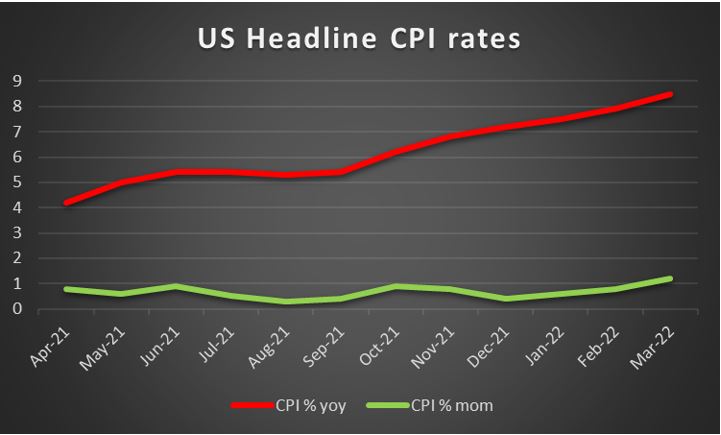
GBP – Uncertain outlook for UK economy weighs
The pound’s retreat against the USD seems to be maintained for a third week in a row, but the pound also weakened against the EUR as well as the JPY for the week. BoE’s interest rate decision, despite BoE hiking rates by 25 basis points on Thursday, and raising the interest rate to 1%, weakened the pound. The bank in its meeting seems to have concluded that inflationary pressures are expected to continue to be high even accelerate. Yet the bank also expects UK GDP growth to slow down sharply, reflecting predominantly the “significant adverse impact of the sharp rises in global energy and tradable goods prices on most UK households’ real incomes and many UK companies’ profit margins”. So on a macro economic level the situation of the UK seems to be uncertain to put it mildly if not difficult, as the spectre of stagflation seems to be hovering over the UK economy.
Overall, the uncertainty of the bank about the UK economic outlook seems to be weakening the pound and we may see the adverse effect continuing to be present in the coming week should BoE policymakers not sound confident in their statements. On the political front, some degree of uncertainty over the UK Government’s strength seems to be maintained. It’s characteristic that in a latest development the conservative party, UK PM Johnson’s own, “lost control of traditional strongholds in London and suffered losses elsewhere in local elections, early results on Friday showed, as opposition parties capitalised on the government’s recent problems” as was reported by Reuters. The uncertainty on a political level is not about to help the pound recover as it may deepen the cautious stance of investors and perplexes also the economic outlook for the UK. As for financial releases we highlight Thursday as the main day of interest as we get from the UK a slew of data including the GDP rates for Q1 and March as well as the manufacturing output growth rate for the same month.
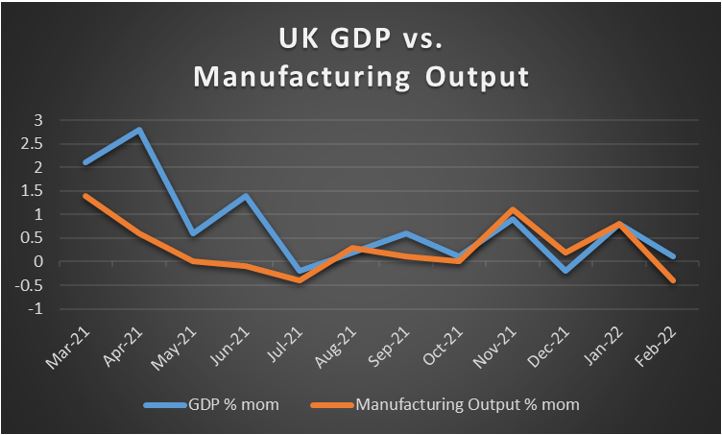
JPY – BoJ’s dovish stance to the test
JPY is about to end the 9th week in a row of weakening against the USD, while its also about to end the week lower against the EUR but not the pound. The news from the land of the rising sun are not so encouraging given that inflation in the wider Tokyo area accelerated beyond expectations for April with the headline rate reaching 2.5% yoy, which was higher than BoJ’s 2% target for the nation. Tokyo’s inflation rates acceleration could be foreshadowing further inflationary pressures in the Japanese economy as a whole due to the density of the population there and is making the understanding of BoJ’s persistence on its ultra loose monetary policy more difficult.
Overall, the bank’s dovish stance tends to weigh on the Japanese currency and a weak JPY tends to intensify inflationary pressures through costlier imports, thus creating a vicious cycle. Thus, its understandable that the fight of BoJ to keep yields low becomes increasingly more difficult and a recalibration of the bank’s yield target could be possible. Analysts’ expectations for a possible market intervention of the BoJ to defend the JPY are still coming and going for which level of USD/JPY would be triggering such a move, yet remain intense and traders should keep this possibility in mind.
On a monetary level, we note the release of the minutes for BoJ’s March meeting on Monday, yet interest may be low given that April’s meeting intervened since then. We tend to place more weight on the release of the summary of opinions for the bank’s April 27-28 meeting on Thursday. On a more fundamental level, JPY is expected to maintain its dual nature as a national currency and an investor’s safe haven, thus remaining sensitive to any tensions in the global political and economic scene. As for financial releases we would like to note the release of the final Jibun Bank Manufacturing PMI figure for April on Monday, the all household spending rate for March on Tuesday and the current account balance for March on Thursday.
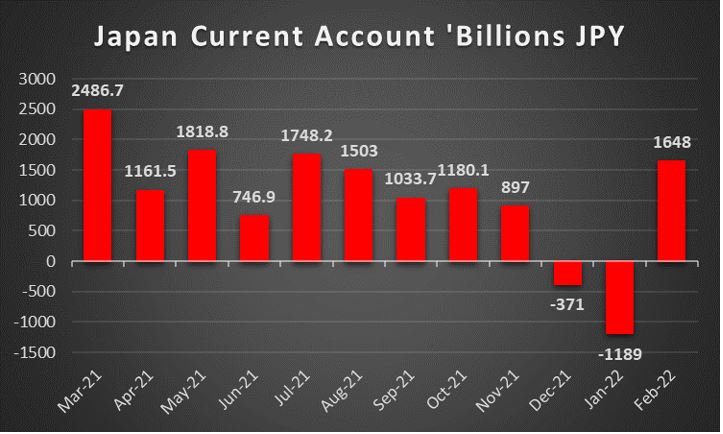
EUR – Germany’s ZEW indicators and final HICP rates eyed
EUR’s drop against the USD seems to have been halted somewhat, while the common currency is gaining ground against the GBP and the JPY as the week draws to a close. Overall the situation on a fundamental level in Europe is not exactly promising given the war in Ukraine, and may deteriorate even further should military operations intensify. The EU seems to be about to ban Russian oil from its markets, yet there seems to be increased reactions within the EU itself, while the bloc does not touch the issue of a possible banning of Russian natural gas, at least not yet. It was worrying that the German Government advised its citizens to stockpile food and water. On the monetary front, signals from ECB officials for a possible rate hike in the summer increased and could support the common currency.
It would be characteristic that the new hawkish comments came after the preliminary HICP rate for the area reached 7.5% yoy. Hence we would like to note that April’s final HICP rates for Germany and France are due out on Wednesday and Friday respectively. Before that though, we note the release of Germany’s ZEW indicators for May. Both the economic sentiment and the current conditions indicators are expected to drop deepeer into the negatives, and if actually so, could be signalling that the sentiment becomes more pessimistic, while conditions deteriorate further for the largest economy in the zone for the current month.
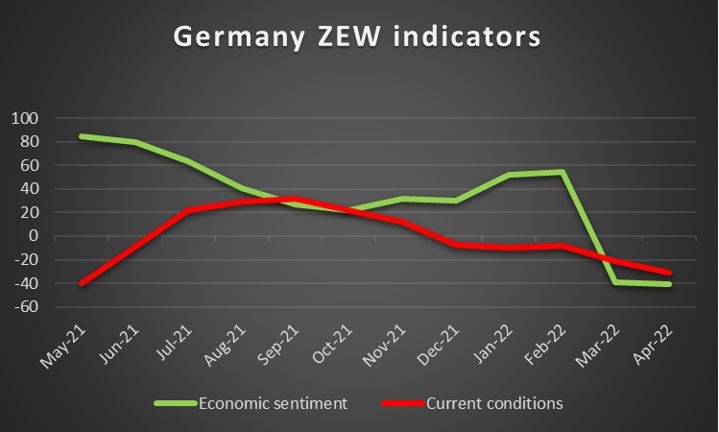
AUD – China’s trade data to watch out for
AUD seems to be standing still against the USD after four weeks of weakening. RBA’s rate hike on Tuesday tended to provide some support for the Aussie. It should be noted that the bank proceeded with a full 25 basis points rate hike despite some analysts considering also a 15 basis points rate hike as possible, thus exciting Aussie traders. In Governor Lowe’s statement the bank stated that “The Board judged that now was the right time to begin withdrawing some of the extraordinary monetary support”. The bank also noted the Australian economy’s resilience which was especially obvious in the labour market while the outlook of the Australian economy remains positive despite ongoing uncertainties like disruption from COVID 19, especially in China and the war in Ukraine.
The bank highlighted that inflation has picked up more than expected and mentioned that it’s “committed to doing what is necessary to ensure that inflation in Australia returns to target over time”, citing also that there are future rate hikes to come in the period ahead. Overall, the bank seems to sound confident and determined to curb inflationary pressures in the Australian economy, while seems to have left behind it any hesitation about tightening its monetary policy, which may continue to provide support for the AUD.
On a more fundamental level, we highlight the contraction of economic activity in China’s manufacturing sector as a threat for the AUD, as the Australian economy exports a high amount of raw materials to China. Hence, we underscore the release of China’s trade data for April on Monday with special focus being placed on the import growth rate for Aussie traders. Other than that we would also like to note the release of Australia’s retail trade growth rate for Q1 on Tuesday, as well as Australia’s NAB business conditions and confidence for April on the same day.
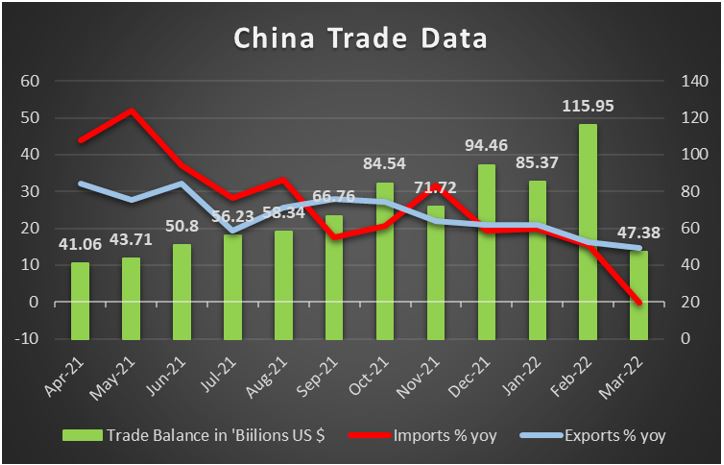
CAD – Oil prices and fundamentals to take over
The CAD seems about to end the week at the same levels it begun on Monday against the USD, yet we have to note that the Canadian as well as the US employment data for April are still to be released and may alter that picture under certain circumstances before the week ends. As for next week’s financial releases from Canada, we note on Monday the release of March’s building permits growth rate. Other than that the calendar for the CAD seems to remain rather empty for Loonie traders hence we would expect fundamentlas to take over the lead regarding the CAD’s direction. A more positive, optimistic market orientation could provide some support for the CAD as a commodity currency and vice versa.
At the same time on a monetary level, should BoC’s hawkishness continue to be present we may see the CAD gainning some support as well. It was characteristic of BoC’s stance, in the past few days of how the bank is trying to regain the trust of the markets in its efforts to curb inflation. It should be noted that BoC Deputy Governor Rogers in a statement on Tuesday noted that higher rates would be required, as inflationary pressures are overheating Canada’s economy. Also the influlence of oil prices should not be underestimated as Canada is a large producer of oil, hence the direction of oil prices could also affect Loonie’s direction.
The commodity seems to be caught in conflicting fundamentals, as on the demand side, China’s lockdown stoke worries for lower demand, while on the other hand the market has expectations for a tigh supply as well. Worries for the supply side of the commodity, seem to persist given also that OPEC decided to proceed with only a modest production hike as reported by Reuters. Oil prices seem to be edging higher in the past few days and should this trend continue we may see them creating some support for the CAD as well.
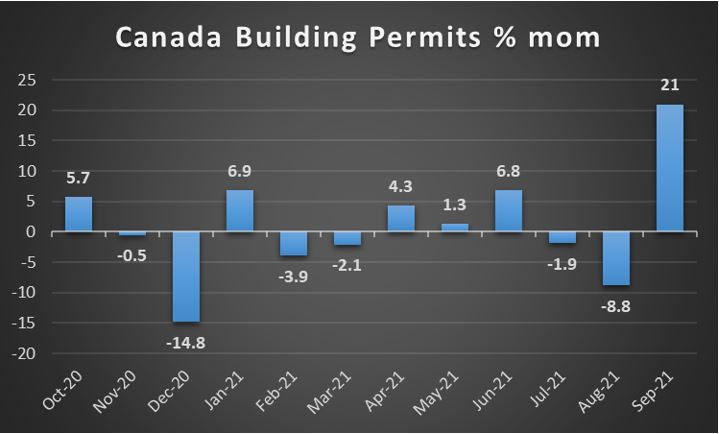
General Comment
As closure, we would like to note that we expect the USD to relent some of the initiative over other currencies, albeit we also note that the release of the US CPI rates on Wednesday for April may prove to cause the strongest market reaction. Overall though a more balanced trading blend is expected and volatility in the FX market may ease as high impact releases and monetary policy events are of fewer number than in the past few days. US stockmarkets at the same time still have the earnings season, yet high profile companies seem to be fewer in numbers. Thus the intensity of the effect that earnings releases have on the market may subside.
Overall, the bearish tendencies are still obvious for the US stockmarkets given that all three of the main indexes, the Nasdaq, Dow Jones and S&P 500 are about to end another week in the reds. Last but not least we would like to make a comment for gold’s price which tended to have a negative corelation with the USD on display once again. It’s characteristic that the yellow metal is about to end the third week in a row in the reds. Yet we would also like to note that the non-interest precious metal could also be affected by rising yields adversely, while uncertainty may cause a flight of investors to its relative safety.
If you have any general queries or comments relating to this article please send an email directly to our Research team at research_team@ironfx.com
Disclaimer:
This information is not considered as investment advice or an investment recommendation, but instead a marketing communication. IronFX is not responsible for any data or information provided by third parties referenced, or hyperlinked, in this communication.













